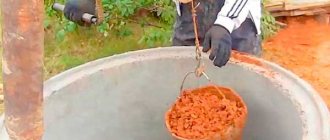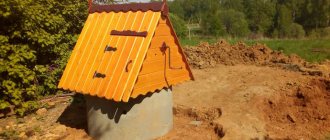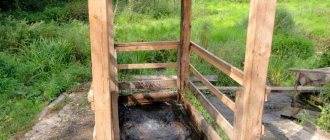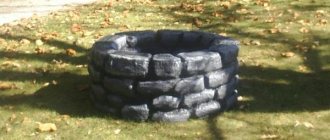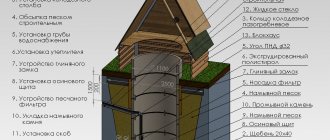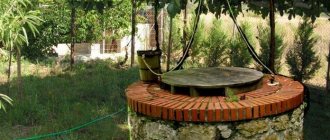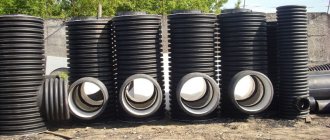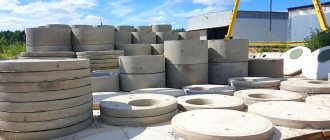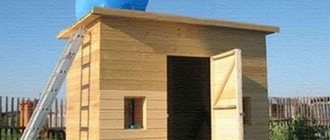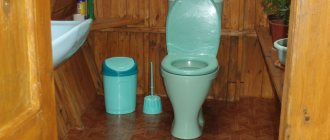Any tank in use needs to be cleaned. And a well filled with surface water is no exception. But, even knowing the need to regularly carry out this procedure, not all owners are ready to shell out large sums for the services of specialists.
Some people do the cleaning themselves - the work is quite labor-intensive and involves certain risks. However, by adhering to the methodology and observing safety precautions, it is quite possible to return the source of water intake to its former purity without the involvement of professionals.
We will tell you the reasons why the tank most often becomes clogged, we will describe how to carry out preventive and comprehensive cleaning of a well with your own hands, and we will also provide tips on maintaining the water intake point.
How to understand that a well needs to be cleaned
A well in any summer cottage requires periodic cleaning, regardless of the quality of the structure and the characteristics of the soil. You can understand that it’s time to clean the well in the village yourself based on several signs.
The water in the well became cloudy and darkened
It’s time to clean the well with special devices if the water in it has become dark, cloudy-greenish and brownish-yellow. Most often, such signs appear when the seal between concrete rings is broken and cracks appear. The liquid can also turn green and dark from simple stagnation due to long-term non-use.
If the water in the well has changed its smell and color, you should not drink it.
The water is dirty and there is garbage floating in it
If the well is poorly cared for, or it is not made well enough, then gradually fallen leaves, twigs, and other plant debris accumulate in it. Sometimes you can even find dead animals in the water.
The water has an unpleasant odor
If carcasses of mammals get into the well or if the mine is depressurized, the water may acquire a fetid sewer odor. At the first such signs, you need to start cleaning.
Well cleaning technologies
There are the following cleaning technologies:
- preventive (disinfection);
- using a drain pump;
- capital (full).
Prevention is carried out every 1-1.5 years, even if the water characteristics have not deteriorated.
Disinfection of a mine with potassium permanganate.
Depending on the material from which the barrel is made, cleaning it has its own nuances. Thus, after removal of deposits and rot from the logs, wooden wells are covered with several layers of antiseptic. During the work, previously unnoticed defects are revealed and the need to replace the crown may arise. Brick structures may require installation of new elements instead of crumbled ones and plastering of the surface.
Preventative manual method
To carry out preventive maintenance, they do not go down into the mine. Water is pumped out of the well and the walls are cleaned using a long pole with a brush or rag at the end; chemical cleaning agents should not be used.
After this, disinfection is carried out with a bleach solution using any of these methods:
- 100-200 g of powder are diluted in 10 liters of water and the walls are treated with a pole.
- After filling the well, pour the solution into it (400 ml per 1 m³) and mix thoroughly with poles or a bucket. The volume of water is calculated based on the fact that in 1 ring with a diameter of 1 m and a height of 0.9 m its content is 0.7 m³.
The head is covered with film, canvas or tarpaulin and a shield so that the chlorine does not evaporate and the sun’s rays do not enter the shaft. The well is left in this form for 8-10 hours if the work is carried out in the summer, and for a day in the cold season. After this, the walls are washed with clean water, pumping out the water until the smell of chlorine disappears. For a week after the procedure, drink water from the well only after boiling.
In addition to bleach, you can use other disinfectants:
- chlorine-containing tablets (for example, “Aquatabs”, “Septolite”), the dosage of each drug is indicated in the instructions, the products are left in the mine for 3-12 hours, this method is also suitable for disinfecting the well;
- “Beliznu” - an aqueous solution based on hypochlorite, use 1 liter per 1 reinforced concrete ring;
- potassium permanganate (potassium permanganate) - 1 tbsp. powder is dissolved in a bucket of water and poured into a well for 2 hours; dry powder cannot be poured into a well.
The cleaning sequence is maintained when using these products.
Prevention with potassium permanganate is considered a gentle method, inferior in effectiveness to the use of products containing chlorine.
Choosing the time for work
In order to clean the well, the best time is when the water level in the well is lowest - in the spring before the flood. At this time, the ground is more stable, there are fewer problems with quicksand and it is safer to work.
It is possible to clean the well in winter, but all sealing work is recommended to be carried out at an air temperature of at least +5°C, otherwise the waterproofing will not have good adhesion.
When performing work on hot days, the barrel walls must be cooled with water every 2-3 hours.
The well should be cleaned before the spring flood begins.
Preparing the necessary materials
For major cleaning, you need to go down into the mine. To work you will need:
- safety rope;
- rope-ladder;
- rope for lifting a bucket;
- metal scraper, stiff brush, sponge, spatulas;
- hammer;
- bucket for lifting sludge and debris;
- special clothing (wetsuit, rubber boots, gloves, helmet);
- wheelbarrow for removing dirt.
A winch with a frame is used to lower the master and tools, lift soil and debris. Cleaning the well should be carried out by 3 people: one works in the shaft, the second takes buckets and supplies tools, and the third insures. A rope ladder or rope with knots is lowered into the well before cleaning begins and removed after the work is completed.
Mine drainage options
Drying is carried out in the following ways:
- bailing out water with a bucket;
- using a hand pump;
- submersible pump of any power.
Pumping water from the shaft to clean the rings.
During major cleaning, it is recommended to pump out the water gradually, as the master working in the mine moves down. Complete drying cannot be achieved, because... the trunk is constantly replenished by sources of underground horizons. The pumped water is poured 20 m from the well so that it does not return to it.
Gases may accumulate in wells with stagnant water. A person can only feel weak concentrations of hydrogen sulfide; he does not feel large and dangerous concentrations, and he does not feel radon at all. Before going down into the mine, they check whether there are any poisonous gases in it: they put a lit candle in a bucket and lower it to the bottom. If there is no gas, the candle will not go out. If it goes out, the gas is removed by waving an armful of straw or ventilating and working in a chemical protection mask.
Treatment of walls and bottom
The walls are cleaned with a soft metal brush or a rough sponge; it is important not to damage the coating; loose concrete is knocked down with a hammer. Start from the top rings and gradually go down to the bottom. It is convenient to treat the walls with a mini-wash - a high-pressure apparatus (up to 14 MPa). It not only washes away plaque, but also cleans the seams of clay and sand more thoroughly than a brush. To operate the sink, use clean water pumped from the well into a prepared container.
When the walls are finished, clean the bottom. Dirty slurry with silt and debris is scooped out manually with a shovel and bucket or using a grab bucket - this is easier and safer. When using it, no people should be in the mine. The device consists of 2 connected buckets with teeth; it is lowered on a rope, the teeth capture the silt, close, and the grab is lifted. It takes several hours to clean the bottom.
After this, the top layer of the filter (gravel backfill) is lifted, washed, and disinfected with activated carbon. It is returned to its place (or a new one is laid) later - after repairing the seams and disinfection.
Sealing and strengthening of seams
First of all, you need to fasten the rings together with staples. Above the soil freezing level, 4-6 staples will be needed to fix one joint; below - 2.
If cracks or seam breaks are detected, depending on the size of the defect, do the following:
- if the gaps are up to 5 cm and water does not seep through them, waterproofing is carried out using sealants, for example “Aquastop”, “Hydrotex”;
- if the holes are larger than 5 cm, water or liquefied soil flows out of them, waterproofing and fine stainless mesh are used;
- Brick is used to repair gaps larger than 20 cm.
If water seeps into the shaft through the cracks, there is no point in using low-grade cement to seal them - it will wash out before it has time to harden. Hydraulic seals “HydroStop”, “Waterplug”, “Peneplug”, etc. seal leaks well, because they are able to quickly polymerize under water.
Means for sealing seams between rings.
Sealing of seams can be carried out both from the inside and from the outside of the well. The second method is much more effective and more complex. For large defects, it is recommended to strengthen the seams on both sides. Liquid glass can only be applied to the outer joints of the rings. A mixture of liquid glass and cement adheres more firmly to the surface.
Chemical impregnation
The walls of the shaft are treated with waterproofing agents (Aquamat-elastic, etc.), which include polyurethane and epoxy emulsions, synthetic resins and polyester and basalt fibers.
Work order:
- The walls are moisturized.
- Apply the product with a wide brush with long bristles using upward movements.
- After the coating has completely dried, which will take about 2 days, apply a second layer.
Impregnation of well walls with a waterproofing compound.
Ready-made mixtures are suitable for treating walls both inside and outside the shaft. They are laid in thin layers, have great adhesive ability, penetrate deep into concrete, fill pores and small cracks, crystallize in them, adding strength and eliminating the penetration of moisture. It is important to choose products designed for drinking wells.
Upon completion of the work, it is recommended to disinfect the walls with a solution of potassium permanganate (1 tsp per bucket of water) or a solution of bleach.
Commissioning after cleaning
Pumping equipment is installed in the mine and they wait for the reservoir to be filled with water. After 2-3 days it is pumped out. After the next filling, the water is allowed to stand for 1-2 days and its quality is assessed - it should be transparent, free of impurities and unpleasant odor. If the condition is unsatisfactory, repeat pumping and settling.
Drainage cleaning
Cleaning with a drainage pump is carried out in the following sequence:
- Measure the distance to the bottom of the well.
- Immerse the unit to a level of 0.6-1 m from the bottom and turn it on.
- To lift dirt from the bottom and destroy the silt, periodically pour out 1-2 buckets of water or use a compressor to supply compressed air to the bottom through a hose.
The most suitable for cleaning a well is a powerful pump that can crush particles of sludge and debris and has a float mechanism to regulate the depth of immersion. There are drainage units that suck water through a hose and work on the surface near the source or on a waterproof raft directly in the mine. But effective cleaning with any drainage pump is possible at a depth of up to 8 m; when lowered, its productivity drops, and at a depth of 20 m it cannot pump out water.
To ensure proper operation of the equipment, it is necessary to study the instructions for its use, especially the paragraphs regarding limitations. Before you start cleaning the well yourself, you should read the recommendations of specialists.
Causes of well contamination
Cleaning the well is a mandatory procedure - it is impossible to use the shaft and not take care of it for many years. There are many causes of pollution, but several main ones can be identified.
Poorly fitting or missing lid
If the mine is constantly open, or its lid does not close tightly, then debris of plant and sometimes animal origin inevitably gets inside. It stagnates and decomposes, which negatively affects the quality of water.
Ideally, it is recommended to equip the well not only with a lid, but also with a canopy
Poorly executed protection against melt water
At the top of any well around the casing ring, a protective layer is required. If it is not there, it is too thin or poorly made, surface water will enter the reservoir every year along with pieces of soil, debris and waste products.
The melt water lock looks like a dense layer of clay around the trunk
Cracks in seam joints
Even if the seams are sealed very well, after the annual frosts they can still crack. Groundwater begins to seep into the well, carrying not only soil particles, but also fertilizers and household waste.
Cracks in well seams inevitably appear; they need to be repaired in a timely manner.
Preventive well cleaning
Preventative cleaning of the well should be carried out annually, at the end of the winter period. The water may not have visible defects, but, nevertheless, it is better to play it safe and carry out the work. It is produced using a solution of potassium permanganate - 1 tablespoon per bucket of water. One bucket will be enough - it is poured into the shaft and left for 2-3 hours. After this, the water is completely pumped out 2 times.
Preventive water purification with a weak solution of potassium permanganate
It is recommended to carry out such cleaning of the well after snow melts and floods. If you rush, sediment and high water may get into the well water, which will make the work pointless. Cleaning may also be required in case of stagnant water. This is typical for dachas where accommodation is seasonal. At the beginning of each season, the water must be pumped out.
How to clean a well from silt, sand or dirt with your own hands
There are several methods and devices for cleaning a well. They allow you to automate and significantly simplify labor-intensive work.
How to clean a well with a pump yourself without going down into it
The easiest way to clean a well made of concrete rings yourself is to use a powerful pump designed for pumping out liquid dirt. When choosing it, you need to pay attention to the performance of the device.
To quickly clean a well with your own hands without helpers, it is better to use two pumps and two containers at once, which are installed on the surface of the earth. One of them is filled with water from a well, and then it is supplied back. The end of the sleeve of a drainage device is lowered into the other, pumping out dirt from the bottom. The jet of water supplied during the cleaning process agitates the sludge and improves the quality of work.
When purchasing a pumping device for cleaning a mine with your own hands, you need to take into account the length of the hose
If the first pump, responsible for backfilling the liquid, is left on the surface, then the drainage device is lowered down and fixed approximately 1 m from the bottom surface. A video about do-it-yourself well cleaning devices recommends taking out the unit from time to time to rinse the filter. When it stops getting dirty, the work can be considered completed.
How to properly clean a well at your dacha with a grab
You can clean a well of clay using a grab, which is the name given to a large bucket that is usually attached to excavators or cranes. In appearance, it looks a little like powerful metal jaws with large teeth. A manual device may look exactly the same as an industrial one, or consist of several “petals” with a similar operating principle.
During use, the grab is securely fixed directly above the well, lowered down on a chain or cable until the jaws hit the ground. When the lifting device is activated, the parts of the device simultaneously close, capturing dirt.
The grab is convenient for removing clay and sand from the well
A manual grab allows you to clean the well yourself in a couple of hours. One person can do the job.
How to clean a well with a bailer
You can clear the drainage well of silt using a bailer. This is the name of a hand-held device that you can construct yourself from an iron pipe, a thick washer and a metal ball. Make the device as follows:
- for the device, select a pipe about 60 cm long; its width should be a couple of centimeters smaller than the well shaft in the narrowest part;
- the bottom of the segment is hermetically sealed with a thick washer, and a grate is welded to the upper part;
- a metal ball of such diameter is placed inside the pipe so that it can completely cover the outlet of the device;
- a handle is welded to the top of the bailer, on which a thin cable can be attached.
Cleaning a narrow well using the device is quite simple. On a cable, the bailer is lowered to the bottom, then raised back about half a meter, and then sharply thrown down again. Do-it-yourself drawings for cleaning wells show that the lower hole of the device will open and water and the sand and silt it carries will enter it. The ball, falling down under its own weight, will block the lower outlet and will not allow the sandy-silt mass to flow back.
Cleaning a well with a bailer with your own hands usually takes at least five hours
To fill the bailer at least halfway when cleaning, you need to lower it with sharp movements several times in a row. After this, the device is pulled out and emptied, and then the procedure is repeated.
Manual cleaning of wells
If special devices are not at hand, or they do not give the desired result, you can only resort to manual cleaning. It is necessary to carry out such work with an assistant who will provide backup.
Manual self-cleaning of a well consists of several stages:
- water is pumped out of the mine using buckets or a pump;
- lower down on a safety rope, simultaneously removing dirt from the walls with scrapers and sponges;
- Clean the bottom of the well using a short shovel, putting the sludge into a prepared bucket.
As the container fills, a second person should lift it to the surface and empty it. Also, during the cleaning process, the incoming water continues to be pumped out; for this, you can use the same bucket if there is no pumping device. Otherwise, the liquid will interfere with the quality of scooping out silt and sand.
Do-it-yourself well cleaning with descent allows you to check the condition of the seams
How to clean a well if there is quicksand
In photos of well cleaning you can often see quicksand. This is the name given to a mobile sand or sandy loam layer, saturated with water, which moves and flows under the influence of soil pressure.
You can clean an old well if there is quicksand in the standard way, manually or using devices. But at the final stage of work it is necessary to equip a special bottom shield with your own hands.
To do this, thick wooden boards with infrequent perforations are placed in the well; the device will delay the movement of sand and clay in the water. A special filter is placed on top of the shield - first large, then medium, and then small stones are poured. The overall layer thickness should be at least 15 cm.
When making a shield against quicksand, it is important to remember that it should be slightly smaller in size than the Council mine itself! Since wood decomposes in water over time, the bottom shield will need to be replaced when cleaning approximately every five years.
Methods for cleaning a drain pump
Pumping out sludge with a pump leads to serious contamination of the device itself. If it is not cleaned in time, it may fail. To clean the unit from sludge, you can use one of the options:
- Clean the device body through the special hole provided in most device models.
Drainage pump device - Manual cleaning. Not the best option, since complete disassembly of the device is required to remove contaminants. But assembling a complex disassembled mechanism can be extremely difficult.
- Automatic cleaning. This method of getting rid of dirt and sand is provided only on expensive modern models.
The cable of the device, which also becomes covered with dirt, must also be cleaned of silt and sand. To prevent re-contamination of the source with deposits from the cable, it must be cleaned at the same time as the pump.
After a one-time major cleaning, the need to repeat the procedure arises much less frequently. The water remains clean and tastes good for a long time.
How to clean oil from a well
Oil can get into the well due to a leak in the pumping device, along with groundwater, or as a result of hooligan actions. In any case, if a characteristic film appears on the surface of the water, you must stop using the mine and urgently remove excess impurities from it.
You can do the cleaning yourself in several ways:
- mechanical - oil is collected from the surface of the water using improvised means, for example, ordinary paper, which is subsequently burned;
- chemical - the liquid is treated with adsorbent substances, among which are activated carbon or aluminosilicates;
- biological - the water is saturated with special bacteria that feed on petroleum products.
When using any of the cleaning methods, after removing the oil, you need to rinse the walls of the well under high pressure, while simultaneously pumping out the top layer of liquid.
You can see the oil in the well even without scooping, by the characteristic reflections when illuminated
Disinfection
For disinfection purposes, a bleach solution is often used. You need to take 20 substances per 1 liter of water. Once the disinfectant has been added, it is necessary to close the shaft with a lid. It should be left in this state for 6 hours. Then the water must be pumped out twice.
Advice! To check the quality of water, it must be analyzed.
More interesting is the drainage cleaning of the well. Such cleaning is sufficient if silt appears in the well, or sand and clay are deposited at the bottom. To work, you will need to use a drainage pump. It is better to give preference to a submersible model. If you know the depth of the shaft and the fullness of the well, you can select an installation with optimal characteristics.
The pump must have a certain power rating. It may also differ in certain requirements for water quality. It is better if the pump has more power and good flow rate.
An excellent solution would be to use a fecal pump. If debris of various sizes floats in the water, it can be removed manually. The drainage pump should be placed half a meter from the bottom of the shaft. The device must be well fixed. It is important that the stream that comes out of the outlet pipe is directed downward. With its pressure it should lift the sediment well.
How to clean a well from bacteria
When a well is contaminated, bacteria inevitably appear in it, changing the color and smell of the water. Usually folk remedies suggest cleaning the bottom of the well with lime. To get started you need:
- remove large debris from the mine using a bucket or other devices;
- pump out all the water;
- clean the walls from soft and hard growths with your own hands;
- seal cracks in the seams between concrete rings;
- remove dirt from the bottom of the shaft manually, using a pump or other special devices.
After this, prepare a 3% bleach solution at the rate of 500 ml of product per 1 m2 of surface. The walls of the well are treated with a thick mixture, and then washed under pressure several times.
Then the water itself is cleaned with chlorine:
- 20 g of 1% lime powder are diluted in 1 liter of cold liquid, the volume of the well is determined and the amount of solution is selected depending on it. On average, 400 ml of product is needed per 1 m3 of water.
- The disinfectant liquid is prepared in the required volume, poured into the well and mixed for ten minutes with a long pole.
- The well is covered with an opaque lid from above and left for 6-10 hours.
After time, the water is completely removed from the well several times with a bucket or pumping device until the specific smell finally goes away.
How to clean a well with potassium permanganate
To clean the well from bacteria, you can use a solution of potassium permanganate. Pour a large spoonful of powder into a bucket of warm water, stir, and then pour into the well and leave for an hour. The walls of the shaft should also be wiped with a brush soaked in potassium permanganate.
After the expiration date, the water is pumped out several times in a row. After the final procedure, a metal sieve with 5 g of manganese powder is lowered to the bottom. A simple device will allow you to make clean water in the well; the product will ensure constant disinfection of the incoming liquid.
When disinfecting a well, it is important to carefully treat the walls; mold and bacteria accumulate on them
Cleaning a well with a motor pump
The motor pump is a pump independent of electricity, the energy source for which is diesel fuel and gasoline. It, like drainage or vibration pumps, is used for cleaning wells and well water.
The motor pump is a pump of very high performance and high suction power compared to a vibration pump and allows you to very quickly pump out clay and dirty water in a large volume, compared to a vibration pump.
To prevent very large stones from being sucked into the hose from the bottom of the filter, you must remember to put a large protective nozzle on its end. It is also necessary to take care of the drainage of pumped water so that it does not flood the immediate area and neighbors.
How to clean water in a well
The quality of well water can be seriously affected by impurities in the soil. It is often impossible to eliminate the reasons for the appearance of unnecessary connections inside the well with your own hands. But it is quite possible to clean the liquid using simple devices.
How to remove lime from well water
If water supersaturated with lime comes from a well, the easiest way is to subject it to a settling procedure. Using a bucket or pumping device, the liquid is simply drawn into an open container and left in a calm state for a day. Large fractions will settle to the bottom under their own weight.
Another reliable DIY cleaning method involves running water through a semi-permeable filter. The most inexpensive and effective sorbent is activated carbon. Such a filter in a cleaning device will need to be changed frequently, but it will be able to retain about 95% of excess particles.
The filter system for well water eliminates the need to wait for the liquid to simply settle.
How to clean rusty water in a well
One of the most common problems faced by well owners is the increased iron content in the water. If the element is trivalent, that is, insoluble, then the liquid will initially have a reddish tint.
Rust naturally precipitates, so you can clean cloudy well water in the same way as if you have too much lime. The liquid is first fed into a large container, where it settles for about 12 hours, and only then is used for drinking and household purposes.
Rust in water appears due to the characteristics of the soil - it is impossible to completely eliminate it in a well
You can also use filtration if it is urgent to supply water from a well to communications. In front of the water supply, devices for rough cleaning, cartridge or sorption elements are installed, which will filter out large and small rusty particles.
How to remove iron from well water
Sometimes well water looks completely clean and clear, but has a metallic taste and turns rusty after settling. This means that it contains divalent soluble iron, which becomes noticeable only during the process of gradual oxidation.
To clean water from such an impurity with your own hands, it is necessary to accelerate the transformation of the element into an insoluble precipitate. The most reliable way is aeration:
- A submersible pumping device is installed in the well, pumping liquid into the barrel on the surface, and a plastic bucket with a watering nozzle in the center is fixed on top of the container above the perforated lid.
- Contaminated water under pressure flies out of the watering can, breaking into small drops. Then the liquid flows down the walls of the bucket and through the holes enters the storage barrel, and from there, after cleaning, it enters the water supply system. The iron sediment remains at the bottom of the container.
When leaving the watering can, water with a high iron content is actively saturated with oxygen and oxidized
Frequency of well cleaning. Cost of service from a private owner
We all understand that the cleanliness of a well depends on how well it is equipped, as well as on proper care of it.
To carry out general cleaning less often, you need to follow some rules:
1. We all imagine a well, which usually has a round shape and is open at the top. If you leave everything as is, then dust, leaves and other debris will get into it, which will lead to instant water pollution. The simplest and most logical solution is to close it. The easiest way is to make a lid (wooden or plastic), but we recommend building a full-fledged mini-house with a well inside.
2. Approaches to the structure must be protected from entry by animals, in particular cats and dogs. Their fur is also a source of pollution. To do this, you can make a fence.
3. Make it a rule to inspect the walls of the well at least once a year, armed with a flashlight. To do this better, lower a powerful flashlight on a rope inside the shaft. This will allow you to see a larger area.
4. It is also necessary to make the structure safe for children by fencing it.
5. If you find any object in the water, you need to remove it very quickly, and if it turns out to be a dead animal, then you must clean the water from the well. To do this, you will need a pump to bail out all the water, disinfect the shaft, and then fill the structure with clean water. If you need to go down, it is strictly forbidden to do it alone; you must be secured from above in order to help you get out if something happens.
Having fulfilled all the care requirements, the frequency of cleaning will be approximately once a year, and sometimes less often. It is worth understanding that in any case, during operation, various deposits and bacteria will accumulate on the walls. Due to seasonal temperature fluctuations, cracks may appear, concrete rings may shift, and dirt may accumulate in the resulting cracks.
The water may become cloudy and have an unpleasant odor. After some time, these signs will disappear, but this only means that all suspended particles, i.e. dregs, settled to the bottom. These and other deviations will be the reason why you need to immediately clean the well and the water in it.
Well, and, in addition, proper installation of the structure from the beginning, the construction of a clay castle, laying the filter on the bottom, etc. is of great importance.
You do not have to do all the cleaning work yourself, because often there is not enough time for this, and if you are willing to pay for this service, you can turn to a private contractor. The price for this type of service starts from 4,000 rubles. and depends on the degree of contamination and depth of the well. The cost of repairs and other work is usually negotiable.
Security measures
When cleaning a well with and without accessories, precautions must be followed. Namely:
- do not go down into the mine without backup and an assistant;
- after pumping out the water, first lower the container with the burning candle; if the latter goes out, there are gases at the bottom that are dangerous to humans, and cleaning must be done in a gas mask;
- perform chemical disinfection with your own hands wearing a respirator, gloves and safety glasses.
Only a person without cardiovascular diseases, hypertension and asthma can clean a silted well. If a well owner suffers from chronic illnesses, he needs a healthy assistant. At the bottom of the mine there is less oxygen in the air than at the surface; during cleaning, this can provoke dangerous attacks of suffocation.
Well cleaning with and without equipment is carried out only during the daytime
Types of equipment used
The market for equipment used for cleaning sand and debris offers two main types of drainage pumps: submersible and surface. Each type has its own characteristics:
Household submersible drainage pumps for cleaning wells
- Submersible drainage pumps for wells are chosen by owners of suburban areas and country houses due to their affordable price, ease of use and the ability to replace (install) the device themselves. The principle of its operation is based on immersion to the bottom of the object being cleaned. This group of units is divided into two types: vibration and centrifugal.
- When pumping with a surface type of apparatus, only the hose is immersed, through which water mixed with sand deposited at the bottom is pumped out.
Cleaning with a grab
Using a grab, the bottom can be cleaned in 1-2 hours. The device must be located at the bottom so that there is free space around it, so it is selected in accordance with the size of the shaft.
If the diameter of the well rings is 80 cm, a grab of the following size is suitable:
- length (opened) 54-60 cm;
- height 54-60 cm;
- width 28-30 cm;
- weighing 12-15 kg.
The volume of such a device is 15-18 liters, it can capture 8-12 liters of soil.
Design Features
The grab is a bucket consisting of 2-4 interlocking moving parts (jaws), the design of which allows you to work in depth without expanding the boundaries of the processed area. It goes deep into the muddy bottom and when the valves join, it captures sediment.
The design for scooping in a well has the following features:
- The central part of the buckets is connected by an oblong hinge, which brings them together;
- the device is suspended on a chain or cable;
- For better capture of deposits, the jaws are equipped with teeth with a height and pitch of 20-25 mm.
The grab is made of metal. Filled with debris, it is difficult to lift it with your hands; it is better to use a lifting mechanism, which consists of 2 metal supports to which the drum is attached. The central chain is welded or laid on it. The grab is not made too bulky: the heavier it is, the more powerful the lifting device is required. But too little weight of the bucket will not provide downforce to grip the soil.
Two buckets are vertically connected to each other in the central part by a lever mechanism on hinges.
Materials and tools required for manufacturing
To clean the well, it is better to make a device of 2 parts - it is easier to use and manufacture.
You need drawings and the following materials and tools:
- sheet steel 2 mm thick;
- a chain or cable, the length of which is 2 times the height of the well with the addition of 2-3 m;
- bolts No. 8 - 6 pcs.;
- roller pin;
- spring mechanism;
- latch rod;
- retaining ring;
- cable roller;
- welding machine;
- cutter.
The main elements of the grab, which are made independently:
- buckets;
- craving;
- traverse;
- eyelets for the rope and for connecting rods and traverses.
Rope blocks, rollers and articulated joints can be made on rolling or sliding bearings. The bearing assemblies are provided with seals that do not require further maintenance. The sharper the grab teeth are, the more dirt they scoop up.
DIY grab device diagram.
Rules for its use
To clean the well, single- and double-rope grabs are used, the rules for their use differ.
Features of working with single-rope devices:
- lifting and connecting the jaws is carried out with one rope;
- each leaf is hingedly connected to the lower and upper supporting bases (traverses), when they approach, the jaws close, and when they move away, they open;
- when unloading, the bucket lock opens after it is completely lowered to the surface, and if the design includes an unloading cable, the lock is forcibly removed in any position of the device and at the moment of opening the head hits the upper crossbar hard.
In a two-rope design, one rope supports the device, the second controls the closing of the valves, it happens like this:
- at the moment of lowering the grab, the second cable is weakened;
- when it comes into contact with the bottom, the supporting rope stops, and the second one is pulled up to ensure that the ground is captured and the valves are closed;
- After connecting the halves, the control rope continues to move upward, and to reduce the load on it and speed up the process, the supporting rope is also included in the work.
A grab of any type is lowered into the shaft with the doors open. After work, it is washed and dried. Store in a dry place.
Grab drawings.
Instructions for cleaning a well with a grab
Clean the well like this:
- Pump out the water and lower the grab.
- Immediately after it lands on the ground, they begin to rise.
- Separate the doors and allow the water to drain.
- Clean off the sand using a small spatula.
- The seals of bearings and other parts of the device must prevent lubricants from entering the source during operation.
- If necessary, remove the old bottom filter, wash it and install it back or replace it with a new one.
During operation, water from the well must be periodically pumped out, then the buckets will go deeper into the ground. It is better to throw the lifted load into a special container installed slightly to the side so that it does not interfere with movement near the well.
Step-by-step operation of a grab to clean a well.
